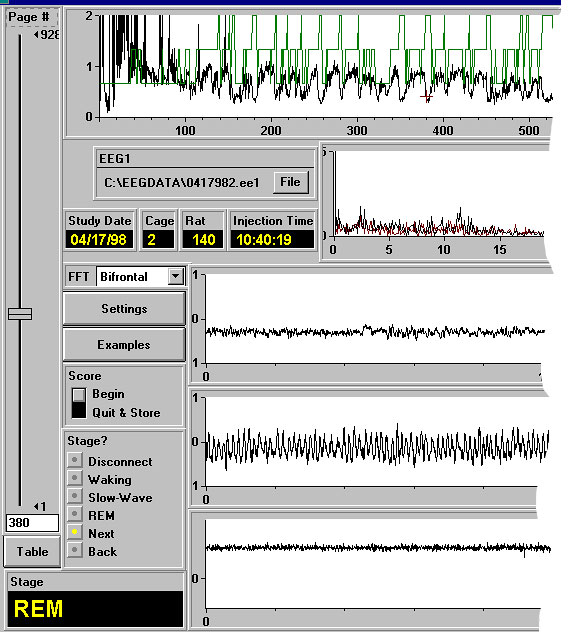These programs were written by Joseph V. Martin and are for collection and analysis of EEG data, using the TestPoint programming language for data acquisition and processing.
The suite of software programs includes
- a program for collecting three channels of electrophysiological data (and the signals encoding the output of the probes measuring brain temperature) in each of eight rats;
- a program for calibration of the temperature probes using a water bath;
- a program for displaying the three channels of electrophysiological data along with a power spectrum of one channel, to allow an investigator to assign a stage of consciousness to each time interval and record that judgment; and
- a program to determine the brain temperature from the recorded thermocouple output.
The programs were written for the following setup:
The electrophysiological signals were amplified through a 26 channel amplifier Model CDA-1100 from Multichannel Concepts (Gaithersburg, MD; 301/340-6084). Thermocouples were attached to TH-5/AOP Thermalert Monitoring Thermometers with Analog Output from Physitemp Instruments (Clifton, NJ; 201/779-5577). The A/D board was a DAS 1802 from Keithley/Metrabyte (c/o K L & M Associates, Fair Lawn, NJ; 1-800-722-0441) and was inserted into a pentium 90 computer.
Downloading and Installing
Fully functional runtime versions of all the programs in the suite are available below as ZIP files (*.ZIP). Unzip the files into a directory of choice and run SETUP.EXE. A directory called C:EEGPROGS is created and the program is installed. Repeat this for each of the programs.
The individual programs (below) may be altered to suit your particular purposes by obtaining the full programming language from Capital Equipment Corporation. These “*.TST” files may all be downloaded at once as MARTIN.ZIP.
- Data Collection Program (RECORD.ZIP) – logs data to disk, resulting in 2 new files each hour, an electrophysiology file (* .EEG) and a temperature file (*.THM)
- Preparation Program (PREP.ZIP) – strips out the data for a single rat from the .EEG files and creates files used in scoring (*.EE1,*.EE2,*.EMG, *.FF1,*.FF2, *.FF3, *.DS1, *.DS2, and sometimes *.ERR)
- Scoring Program (SCORE.ZIP) – Displays data in 30 second epochs and allows assignment as “Disconnect”, “Waking”, “Slow-Wave”, or “REM”. A graphical representation of the power summed over the 1-8 Hz range according to the time is displayed (top trace) to put the particular epoch in context of the overall study (top trace). The FFT for the epoch is displayed (second trace) along with bifrontal EEG (third trace) and fronto-occipital EEG (fourth trace) and EMG (bottom trace). A variety of filters can be applied by pushing the “Settings” button and good examples of each sleep stage can be stored for reference by pushing “Examples”. Results are put into a file with the extension *.SCO.

- Print-out Program (PRINTOUT.ZIP) – dsiplays the score sheet for a given rat on a given day.
- Pre-test Check-out Program (5SECDSP.ZIP) – displays five seconds of data for a selected rat and the output reading of the signal from the thermometer box. By testing the thermometer output at 2 temperatures one can arrive at a slope and intercept for the response of the box, thereby calibrating the temperature readings.
- Temperature Calibration File (CALFILE.ZIP) – creates a file with the slopes and intercepts of the temperature responses from above (*.CAL)
- Temperature Decoder File (TEMP-DEC.ZIP) – uses *.CAL and *.THM files to determine the temperatures measured.